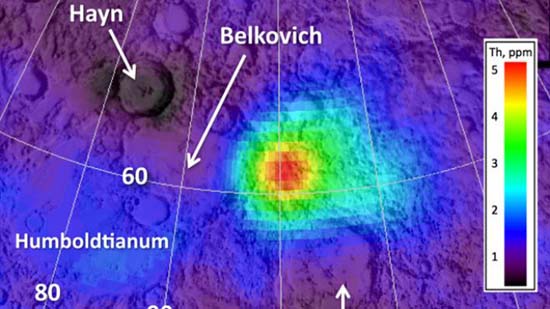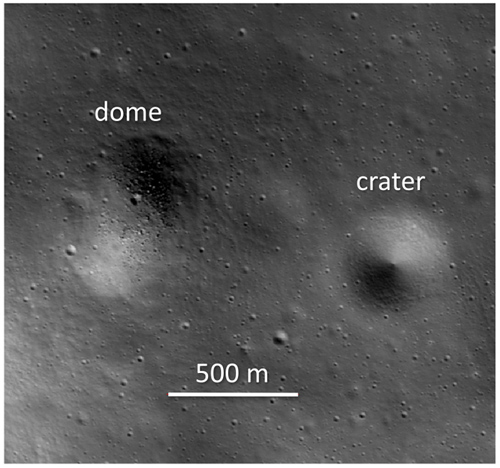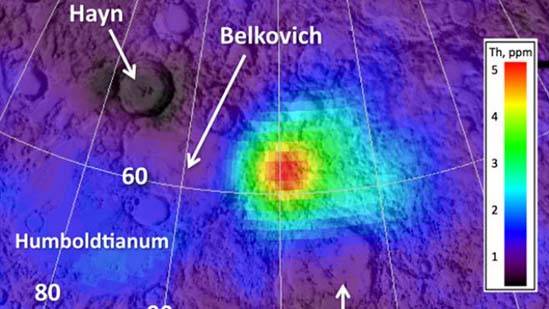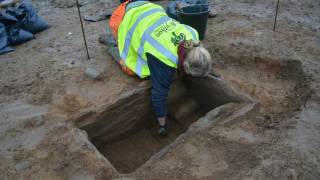Rare Volcanoes Discovered on Dark Side of the Moon
Source: foxnews.com
Shielded from Earth-bound eyes, the far side of the moon is home to a rare set of dormant volcanoes that changed the face of the lunar surface, a new study finds.Data and photos from NASA’s Lunar Reconnaissance Orbiter (LRO) reveal the presence of now-dead silicate volcanoes, not the more common basaltic volcanoes that litter the moon’s surface, researchers said.

This image from NASA’s Lunar Reconnaissance Orbiter shows a region on the far side of the moon between the Compton and Belkovich craters. The colored region marks a high amount of the mineral thorium, which is thought to have been deposited by rare silicate volcanoes in the past.NASA/GSFC/ASU/WUSTL, processing by B. Joliff
"Most of the volcanic activity on the moon was basaltic," primary author Brad Jolliff of Washington University told SPACE.com in an email. "Finding other volcanic types is interesting as it shows the geologic complexity and range of processes that operate on the moon, and how the moon’s volcanism changed with time."
Searching the far side
Because the moon’s rotation has been affected by tidal forces between the Earth and the moon, only one side of the moon is visible from the Earth. The far side of the moon — sometimes referred to inaccurately as the "dark side" — was hidden from view until 1959, when Soviet Union’s Luna 3 spacecraft took the first photos of the region.
When NASA’s Lunar Prospector probe circled the moon in 1998, it revealed a highly reflective plain lying between two ancient impact craters. Known as the Compton-Belkovich region, this part of the moon contains thorium and other silicate rocks, suggesting a more involved type of volcanic activity than that which created the moon’s well-known dark plains of basaltic plains known as "maria," or "seas."

Sunlight grazes over a small dome in the central part of the Compton-Belkovich complex on the far side of the moon in this image from NASA’s Lunar Reconnaissance Orbiter. The dome was likely formed by rare, viscous lava on the moon.
CREDIT: NASA/GSFC/ASU
But it wasn’t until the LRO captured higher-resolution images for the region could this volcanic activity be confirmed. The spacecraft found a number of domelike features with steeply sloping sides — telltale signs of lunar volcanoes.
Jolliff said that the domes likely formed by lava probably came from deep within the moon. It flowed upward through cracks to pool just beneath the surface, where it pressed out to form large domes.
Lava continued to work its way to the surface throughout the area, building other, smaller volcanic domes. Some areas then collapsed, creating the irregular depressions observed by LRO’s camera, researchers said.
The research is detailed in the July 24 edition of the journal Nature Geoscience.
Rare volcanoes on the moon
Most volcanoes, on Earth and off, are near other volcanoes. But the grouping in the Compton-Belkovich region is isolated.
"This small volcanic complex occurs far away from the part of the moon where most of the volcanic activity was concentrated, and where other silicic volcanism occurred," Jolliff said. "That’s a puzzle."
Older, defunct volcanoes are not themselves uncommon. Scientists have known for years that volcanoes on the moon filled in craters to form the dark maria visible from Earth’s surface. However, those lava flows are basaltic in nature.
The team also used the Diviner Lunar Radiometer Experiment to confirm the type of rocks on the plain.
"Very few minerals have an infrared spectrum that can explain Diviner’s observations of Compton-Belkovich and the other nonbasaltic volcanoes on the moon," study co-author Timothy Glotch of Stony Brook University told SPACE.com via email.
In fact, the rocks were silicate-rich.
"We’ve known for awhile that the Compton-Belkovich had an unusually high thorium content," Glotch said. "Now we can positively say that that thorium is related to these silicic volcano materials."
Volcanoes on the moon
Last fall, Glotch, working with another team, was the first to identify nonbasaltic volcanoes on the near side of the moon. Due to their highly reflective surface, this group was also originally noticed by the Lunar Prospector.
However, lava from the surrounding maria may have also concealed details of the volcanoes, so some details of the region’s geologic history could have been hidden, researchers said. But the volcanoes on the far side have no maria nearby to hide their features. The complete view of the volcanism in the area lies open to examination.
Similarly, they are surprisingly free from impact craters, which reveals a great deal about their age, researchers added.
The early life of the solar system was violent, with rocks scarring the surface of the planets and their moons. Features that lack this scarring formed after things had calmed down.
Jolliff and his team estimated the age of the moon’s rare far side silicate volcanoes to be about 800 million years old. Such an age would extend the volcanic activity of the moon by 200 million years, they said.
Read the full article at: foxnews.com
Also tune into:
David Icke - The Cosmic Firewall & The Moon Matrix
David Icke - The Moon and Saturn Matrix
Walter Cruttenden - Ancient Cosmology: A Map of the Future
Mike Bara - Dark Mission, The Occult NASA Moon Mission
Wallace Thornhill - The Electric Universe
Jay Weidner - Kubrick’s Odyssey & The Brotherhood of Saturn
Alan Watt - Moon Landing, UFO’s & Fake Alien Threat






















